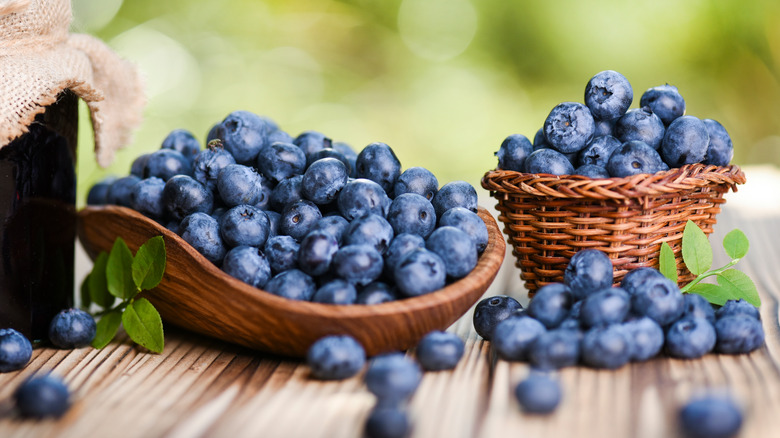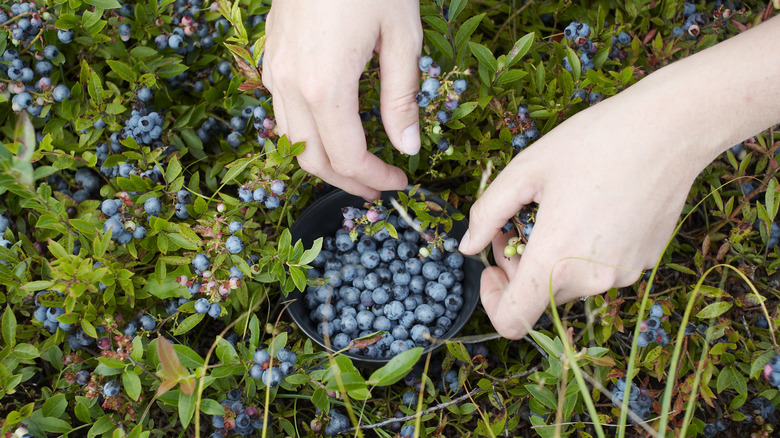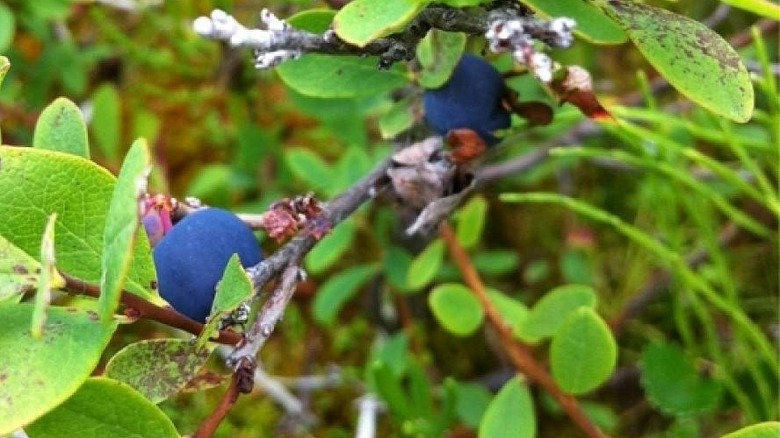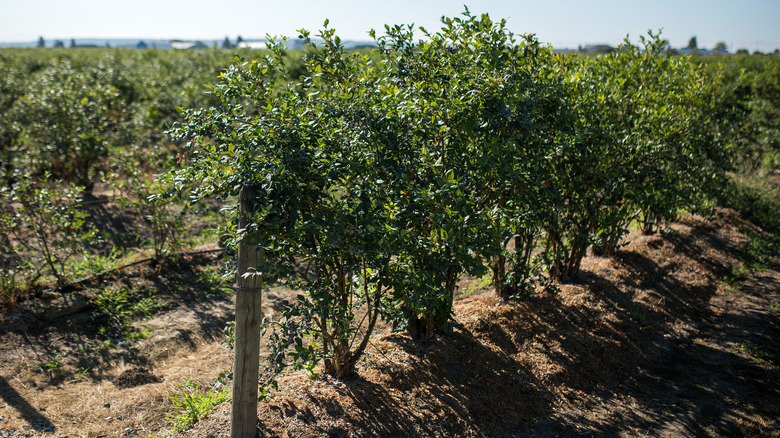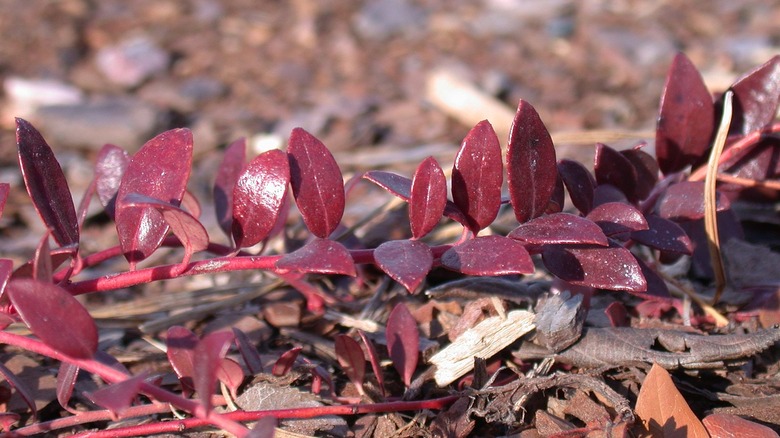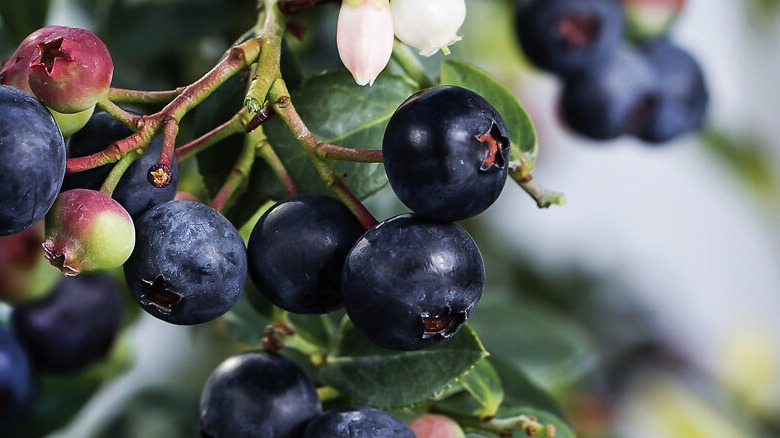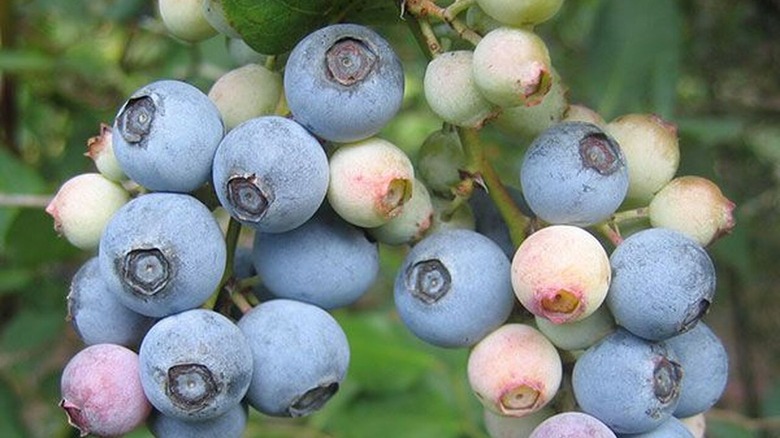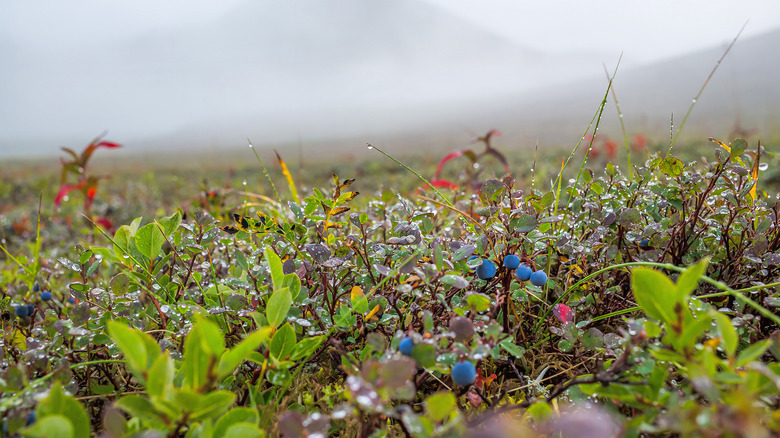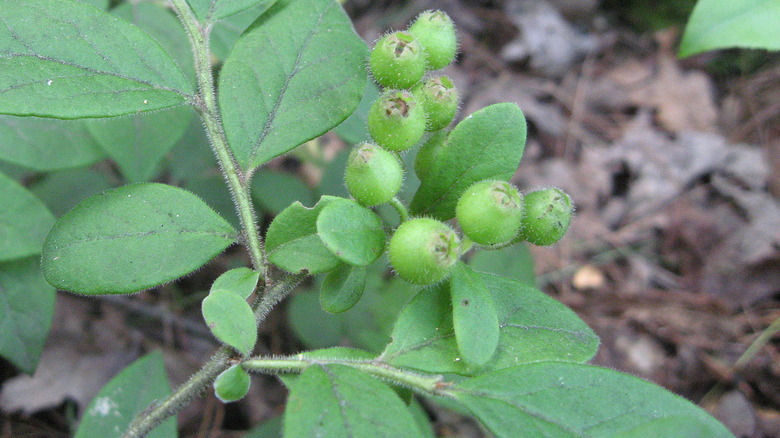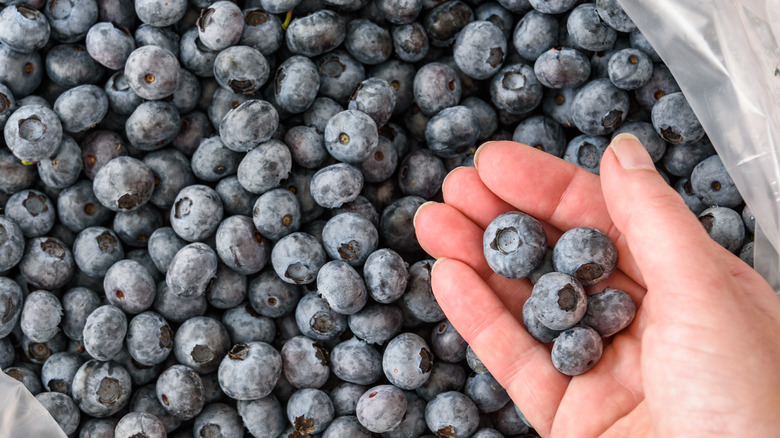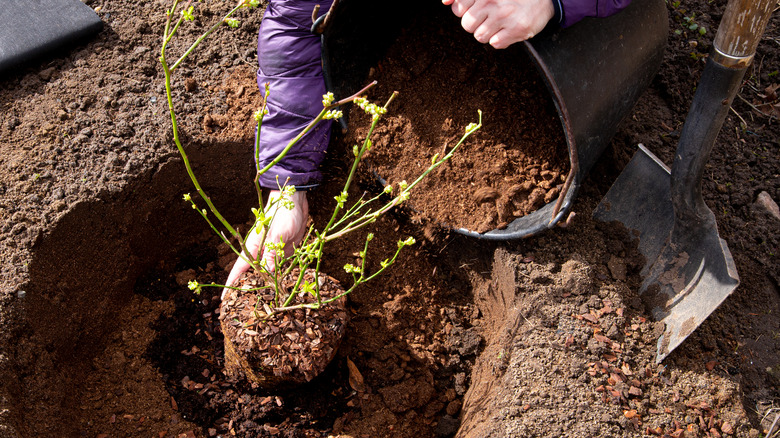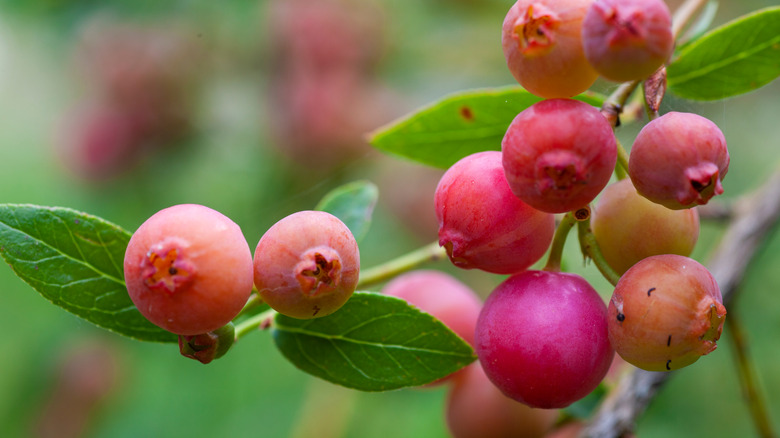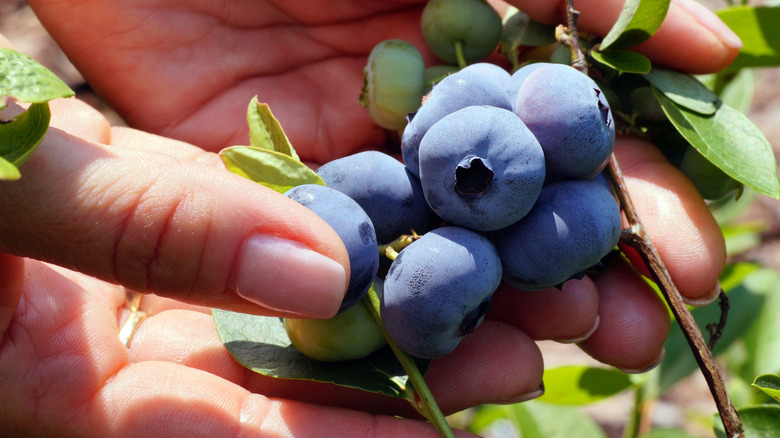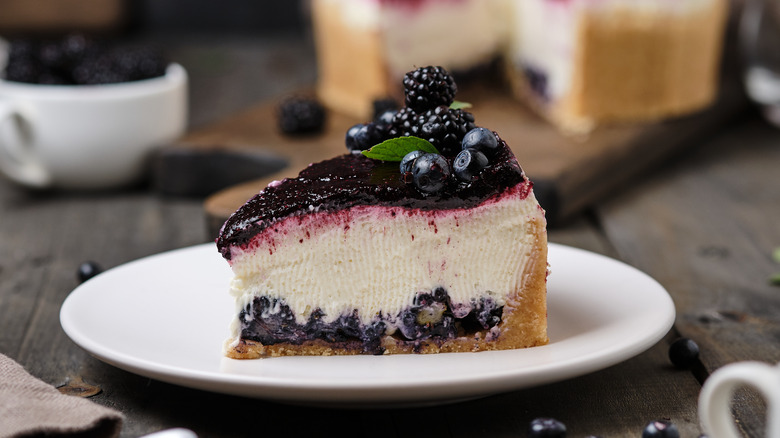15 Types Of Blueberries And What Makes Them Unique
When it comes to the world of fresh fruit, blueberries are one of the most flavorsome and versatile berries out there. Because of their conventionally sweet taste, their tiny seeds, and the fact that they are so accessible, it's hard to pass them up.
Blueberries can be utilized in many foods such as cobblers, muffins, ice creams, and more. Although these fruits are commonly appreciated by bakers worldwide, they can also be eaten raw or cooked into savory meals. Remarkably, there are nearly 150 distinct varieties of blueberries, according to Harvest to Table. Out of the wide varieties that nature has to offer, there are a few different kinds that stand out. Whether they provide a unique flavor or have peculiar looks, these 15 types of blueberries will have you in awe of their unique characteristics.
Lowbush blueberry
If you've ever had blueberry jam or preserves, odds are you've tasted this lovely berry. Lowbush berries are small and can be dark in appearance, but they have an impeccable texture and flavor, making them perfect for commercial canning. Although they are most commonly used for canning, they are also used for other purposes such as horticultural farming and the frozen food industry. According to the FEIS Plant Species Index, the need for this type of blueberry increased in the 1940s as the culinary scene began focusing on frozen foods. Overall, this fruit is a superstar when it comes to its characteristics.
Northern blueberry
Often mistaken for the lowbush blueberry, the fruit and plant of the northern blueberry are visually similar to the lowbush. Notably, the northern blueberry has shorter leaves and stems, while the berries themselves are slightly smaller in appearance (via Newfoundland & Labrador Flora). The fruit is also more robust in flavor, providing a sweet flavor that shines beautifully in recipes like this blueberry clafoutis recipe. If you're looking for a plump and decadent fruit, this one will surely not let you down; however, as its name suggests, the plant usually only grows in northern states, specifically northeast states such as New Hampshire and Maine. This shrub can also be found flourishing in Canada as well.
Alaska blueberry
If you wanted to take a wild guess and bet that this berry is cultivated in Alaska, you would be correct. Additionally, it can be found in other surrounding areas such as Canada, Washington, Oregon, and Idaho. What makes this berry so unique is that it is a hybrid variety, a berry with the genetics of blueberry and red huckleberry. The result of this is a beautifully juicy and tart fruit that is perfect for eating raw or even cooking. According to the FEIS, the history and importance of this berry go back in time; the Native people of Alaska relied on its abundant nutrients to nourish their bodies and survive through cold seasons. The Alaska berry has proven itself to be not only a critical food source but also a delicious one as well.
Highbush blueberry
Living up to its name, the highbush blueberry plant has the potential to grow and tower as tall as 12 feet high, according to NC State Extension. This berry is seen across the board, appearing in grocery stores all over America, making it widely available. A plant cultivated for mass production, highbush blueberries are farmed, making them different from wild blueberries. Whether you're planning to make a blueberry pie or perhaps a fresh berry smoothie, the highbush blueberry will be the fruit to get the job done. In addition to its succulent nature, the fruit also contains a high amount of iron, providing potential health benefits to its consumers. It's no wonder this blueberry is so common.
Creeping blueberry
The creeping blueberry is another fruit that grows in the wild but is perfectly edible. It has a rich flavor and offers flexibility because it can be enjoyed uncooked and baked. For instance, this blueberry is great in blueberry pancakes or perhaps tossed in a fruit salad. This variety is unique because it exclusively grows domestically in four out of 50 states; Virginia, Georgia, North Carolina, and South Carolina (via NC State Extension). The plant provides beautiful foliage with colorful, velvety, and stocky leaves. It typically spreads throughout an area, hence its name. The creeping blueberry might become your new favorite fruit if you're lucky enough to devour one.
Shiny blueberry
What is it about shiny things that make them so appealing? It's not uncommon for jewelry and other objects to sparkle, but for a berry to be naturally shiny is not something you see every day. This fruit is not only intriguing to look at, but it is plump and has a flavor so luscious that it is usually eaten fresh without needing to be cooked. In addition, the fruit contains a dense amount of vitamin C, which is beneficial for your immune system, according to the Harvard School of Public Health. If you're looking for shiny blueberries, your best bet to finding this exceptional berry is at a nursery or farmers' market.
Oval-leaf blueberry
Japan, Canada, the United States, and the United Kingdom are some places where the oval-leaf blueberry grows. Unlike other blueberries that are domestic to specific regions, the oval-leaf blueberry has the potential to grow in many different climates and places. The berry appearance is a bright blue, and its size is considerable compared to other species of blueberries.
The fruit has a slight but pleasant bitterness, making it the perfect catalyst for making wine, with some even winning international awards (via Kermode Wild Berry Winery). If you can't get your hands on oval-leaf blueberry wine, you can try throwing the berries into an easy wine slushie recipe to see how well the flavors pair together.
Rabbiteye blueberry
While most blueberry varieties are typically small and beady, the rabbiteye blueberry stands out for its vast size. Although most rabbiteye berries are about the size of a dime, some have the potential to reach the size of a nickel in diameter (via Texas A&M AgriLIFE Extension). Now that's a big berry!
For the best, rich flavor, don't pick these blueberries prematurely. The main reason is that they can come off as tart if you're not careful about when they're harvested. As a highly versatile fruit, you can bake these berries, dry them, freeze them, or eat them fresh, so there is no stopping what kind of foods you can incorporate these fantastic blueberries.
Bog blueberry
When it comes to health benefits, bog blueberries know how to pack a punch. These berries appear to be an average blueberry with a deep blue color and generally grow to be less than 2 cm in size. The plant grows in treeless regions and meadows but can be found in several countries. Regarding its potential health benefits, the bog blueberry contains an abundant amount of flavonoids, according to American Botanical Council. These flavonoids, such as anthocyanin, are believed to reduce the risk of heart-related diseases and promote healthy cardiovascular systems. In addition, regularly consuming blueberries high in flavonoids can reduce the likelihood of type 2 diabetes (via American Society for Nutrition). In short, bog blueberries are not only rich in health benefits it's also bursting with great flavor.
Hairy blueberry
Of all the different kinds of blueberries, the hairy blueberry wins for having the most peculiar look. With a natural habitat of swamp, bogs, and the edge of lakes, this unique-looking blueberry is a treat. Once ripe, the berries have a deep shade of blue, so dark that they almost appear black (via NC State Extension). The soft fuzz that encompasses the outer skin makes them incomparable to other blueberries. In fact, the plant stems are just as hairy as the berries, so the whole shrub is quite stubbly. But don't let the fuzz fool you; hairy blueberries are still edible and delicious, either raw or cooked.
Duke blueberry
The Duke blueberry is one that naturally grows in the pacific northwest region of the United States. Its remarkable shelf life makes this berry stand out from other varieties of blueberries. Many may not know, but when berries and other fruits are picked and set aside (sometimes for months for fruit like apples), they typically lose nutritional value, according to the University of California, Davis. This is why it's beneficial to eat berries when they are in season, to consume them when they are at their freshest point. Luckily, for the Duke blueberry, its taste holds up through storage, making it an excellent berry for transporting (via Pacific Northwest Extension Publication). This gives Duke blueberries leverage for commercial production and year-round enjoyment.
Olympia blueberry
The Olympia blueberry is another berry domestic to the Northwest. Interestingly enough, it has yet to exist for 100 years. According to Raintree Nursery, the fruit was originally cultivated in 1933. Once ripe, the fruit is dark in color, ranging from shades of blue to deep purple hues. The Olympia is known for its intense flavor, bursting with sweetness, making it appealing for activities like baking. Many home gardeners enjoy growing the plant because of its plump fruit. The plant's foliage turns to shades of orange and red during autumn, making it a beautiful addition to their landscape and garden.
Pink lemonade blueberry
Without a doubt, this berry has a few distinct characteristics that make it unique. The first question is, what are pink lemonade blueberries and what do they taste like? These berries are indeed a variety of blueberry even though they offer a different appearance and unique flavor. The fruit assuredly lives up to its name because, unlike other blueberries that range from shades of blue to purple or black, this berry presents itself as a vivid fuchsia. Many may mistake it for being an unripe berry because of its hue, but it is most certainly just as vibrant when it is ready to be harvested. According to Mashed, the fruit also has an apparent lemon-like tang, making its label even more fitting. This berry will make any dish stand out with its enchanting presence, but how about making some fresh blueberry lemonade to start?
Darrow's blueberry
Darrow's blueberry is classic-looking — a beautiful blue-tinted pearl that can be enjoyed raw or used for cooking and baking. What makes this fruit so notable is its exceptional ability to attract native bees (via University of Texas at Austin, Wildflower Center). The plant domestically grows in Florida, although it can be found in other states such as Alabama, Texas, or Mississippi. The native bees must have access to nature, like the Darrow's blueberry plant, as a means of survival, according to Xerces Society. If you can get ahold of the berry before wildlife such as deer, birds, and rodents, you will find that it provides a unique flavor for a blueberry; a delightful combination of sweet with tart (via One Green World).
Black highbush blueberry
You might have noticed a waxy, natural coating on fruit if you've eaten fresh berries or certain fruits such as plums or apples. Most species of blueberries have this film on them, which is entirely harmless. The black highbush blueberry, however, doesn't have that white-tinted layer, making its appearance somewhat glossy (via NC State Extension). When the fruit is ripe, it turns out to be a magnificent deep color, bordering between dark blue and black. The berries are of great size, have flavorful flesh, and can be eaten in many ways. Putting them into a fresh açaí bowl or making a fluffy blueberry cheesecake are just two ideas for this versatile blueberry.
